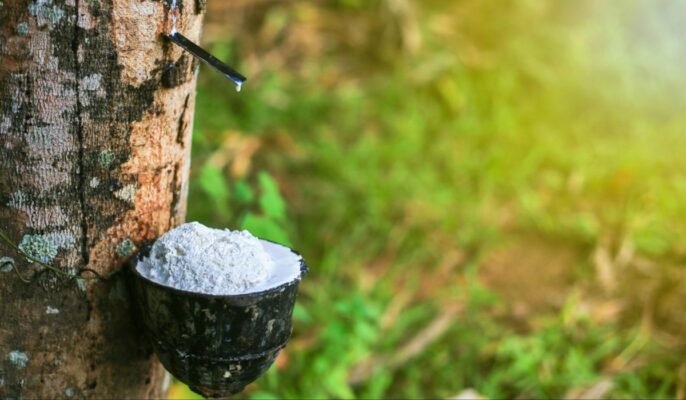Hevea brasiliensis, the botanical name of the popular rubber tree, is widely grown for its immense commercial use in natural rubber production. The milky sap of the rubber tree, known as latex, is extracted and used for making natural rubber. Hevea brasiliensis belongs to the rubberwood species mainly found in the Amazon rainforest areas of South America.
See also: Rubber Plant – How to Propagate and Care for Ficus elastica
Hevea brasiliensis: Quick facts
| Plant name | Hevea brasiliensis |
| Common names | Pará rubber tree, Rubber tree, Rubber plant Sharinga tree and Seringueira |
| Family | Euphorbiaceae |
| Found in | Amazon basin, South America |
| Flower colour | Creamy-yellow |
| Toxicity | Mild |
| Benefits | Commercial use for producing natural rubber |
see also:all about Euphorbia Prostrata
Hevea brasiliensis: Description
- It is a flowering plant and produces pungent flowers that are creamy-yellow and without petals. It has softwood with high branching limbs and a large bark.
- The trees mainly grow in low-altitude moist forests, riparian zones, wetlands, forest gaps and disturbed areas.
- The white or yellow sap appears in the latex vessels inside the bark, usually outside the phloem.
- The trees in the wild can grow up to a height of 140 feet or 43 metres, while the plantation trees are smaller. This is because the growth is slower when tapped for latex and trees are felled after 30 years as latex production decreases with age.
- The plant leaves appear as three leaflets with a spiral arrangement.
- The fruit of the rubber tree is a capsule with three large seeds. Once ripe, it opens explosively. The fruits are small, oval and yellowish-green.
Hevea brasiliensis: Rubber tree plantation
The rubber-containing latex is gathered by making a thin shaving in the bark using special tapping knives. The latex is collected in small containers through rubber tapping. It takes around seven to ten years for the natural rubber tree to deliver the first harvest.
Wood harvesting
Latex production decreases with age. Rubber trees are usually cut down after 25 to 30 years. The wood is used in furniture making.
Hevea brasiliensis: Uses
The species was first discovered by the ancient Olmec, Maya and Aztec ethnic groups. The sap was once used to manufacture rubber balls, waterproof clothes and homemade shoes. Latex, today, is utilised in rubber processing. The production of natural rubber and its export has been significant for the economic growth of rubber-producing countries.
The latex of the rubber tree is concentrated for producing dipped goods, like surgical gloves.
Hevea brasiliensis: History
Owing to the rising demand for the rubber plant and the discovery of the vulcanization procedure in 1839, cities, such as Santarém, Belém and Manaus in Brazil and Iquitos, Peru, began to grow rubber trees between 1840 to 1913. Before this period, the growth of the South American rubber tree was restricted to the Amazon rainforests. In Brazil, the plant’s initial name was ‘Pará rubber tree’, which was changed to Seringueira. In Peru, the tree was known as Árbol del Caucho and the latex was referred to as Caucho. Until the beginning of the second World War, natural rubber was the main source of elastic materials. Since the 1950s, there have been a variety of oil-derived synthetic rubbers but natural rubber continues to have significant demand due to its specific properties.
Hevea brasiliensis: Care
The hevea brasiliensis tree needs tropical or subtropical climatic conditions with around 1,200 mm per year of rainfall. Frost can damage rubber production, causing the rubber to turn brittle and break once refined.
- Sunlight: The tree requires 6-8 hours of sunlight every Lack of sunlight can cause the leaves to fade.
- Water: The plant needs watering once a week. The soil must dry out between waterings.
- Humidity: The plant can withstand various humidity levels, including normal room humidity.
- Soil: The plant grows well in acidic, volcanic, peaty soils. Although the plant can withstand waterlogging and drought conditions, well-drained soil is more suitable for their healthy growth.
FAQs
Are rubber trees poisonous?
Rubber trees may be mildly toxic, causing irritation of the mouth, diarrhoea and vomiting.
Are rubber fruits edible?
Rubber fruits are not edible. They contain fertile seeds only in the regions where pollinating insects are present.
Harini is a content management professional with over 12 years of experience. She has contributed articles for various domains, including real estate, finance, health and travel insurance and e-governance. She has in-depth experience in writing well-researched articles on property trends, infrastructure, taxation, real estate projects and related topics. A Bachelor of Science with Honours in Physics, Harini prefers reading motivational books and keeping abreast of the latest developments in the real estate sector.

